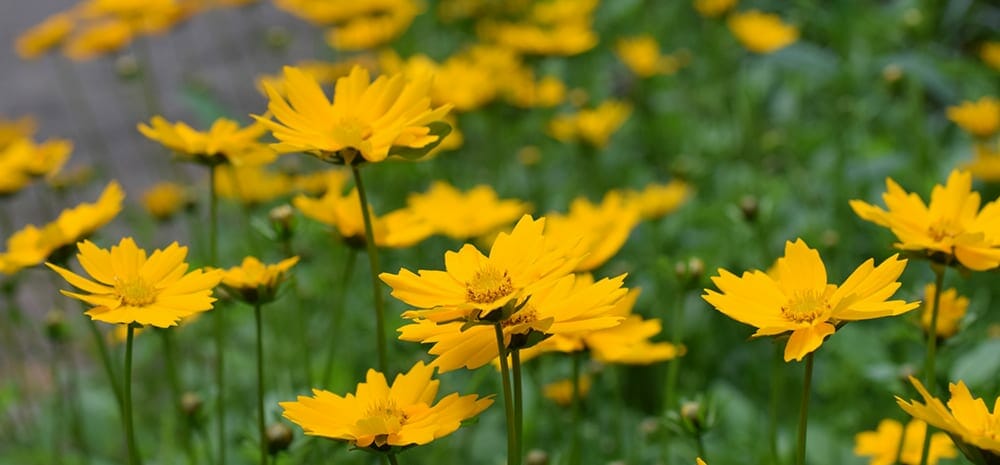
Coreopsis auriculata, also known as mouse-eared tickseed or lobed tickseed. Photo by Ellen Honeycutt.
Georgia Native Plant Society is blooming!
We are excited to announce that six new chapter interest meetings are being held this month!
If you are interested in being part of a forming chapter in any of these areas; Athens, Augusta, Intown Atlanta, Macon, North Georgia Mountains, or North Metro Atlanta, please click on the link to register for the meeting. During the meeting, we will talk about the chapter name, meeting venue, first steps, and more! After you register, you will receive instructions for joining the meeting.
North Georgia Mountains Chapter - Tuesday, May 4 at 7 p.m.
Register for the North Georgia Mountains virtual event
Athens Chapter - Saturday, May 15 at 7 p.m.
Register for the Athens virtual event
Macon Chapter - Sunday, May 16 at 2 p.m.
Register for the Macon virtual event
Augusta/Central Savannah River Area Chapter, Tuesday, May 18 at 7 p.m.
Register for the Augusta virtual event
North Metro Atlanta Chapter - Wednesday, May 19 at 7 p.m.
Register for the North Metro Atlanta virtual event
Intown Atlanta Chapter - Tuesday, May 25 at 7 p.m.
Register for the Intown Atlanta virtual event
If you have questions about these meetings or are interested in starting a new GNPS chapter in your area, please email membership@gnps.org.
Have you ever wondered where GNPS members are located? Here's a map of members by city. The size of the circle indicates the number of members in that area. The smallest circles represent one member and the largest circle (Atlanta) represents 220 members.
Wildflower license plates are not all that they seem

Read below to learn why you might want to give up your wildflower license plate for something new and just as attractive. (Images courtesy of Georgia Dept. of Transportation and Georgia Dept. of Natural Resources.)
You've probably seen the Georgia license plates
that feature wildflowers, and maybe even you have one yourself. But did you know that this only supports the Georgia Department of Transportation Wildflower Program, and it does not support programs in the Department of Natural Resources that are dedicated to conservation of flora and fauna? The Wildflower Program has many benefits, but unfortunately it frequently uses non-native plants, including invasive plants like Cosmos sulphureus, and it could be doing this along highways adjacent to critical habitat. It's one thing to selectively use non-native plants in your home landscape, but sowing them across large areas is a concern.
So, what can a GNPS member like you do to help? For starters, you can consider contacting the DOT at the address given on their website, commending them on their efforts and asking them to focus on using exclusively native plants. But a much quicker way to directly support conservation is to instead purchase a Georgia DNR license plate. The Georgia DNR does outstanding work with native plants and environmental restoration. GNPS has benefited from the wisdom of DNR speakers at our educational events, and we actively seek partnerships with them. The Butterfly plate shown above, as well as the patriotic Bald Eagle and American Flag plate, directly supports Georgia’s Wildlife Conservation Fund. As they state on their web site, "In addition to supporting conservation, education, and population monitoring and restoration efforts, these funds help acquire thousands of acres of wildlands open to Georgians. Renewing the older eagle and ruby-throated hummingbird plates also supports this work."
There are also DNR plates that support conservation programs related to game animals, fish habitat, and enforcement of wildlife regulations, which may fit your priorities, too. But please think about that nice butterfly or eagle plate when renewing your tags!
Plant Spotlight: Chionanthus virginicus
Ellen Honeycutt
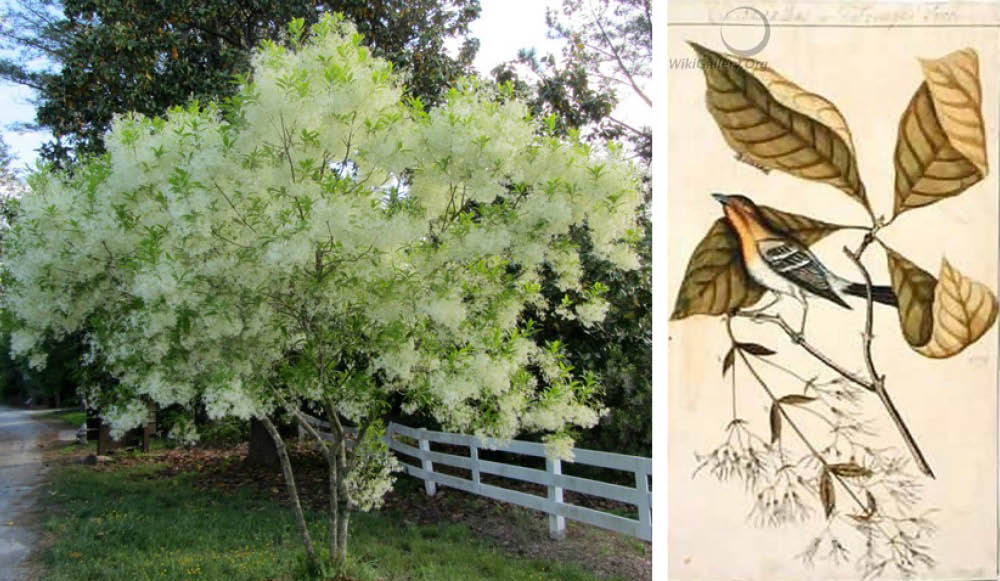
Left: Fringetree in full bloom (photo by Ellen Honeycutt). Right: Willam Bartram’s painting of fringetree (http://www.wikigallery.org/).
Our Plant of the Year for 2021, as chosen by our members in November 2020, is fringetree (Chionanthus virginicus). As we finish up its bloom season, this month is an appropriate time to educate people about this beautiful native tree. Native throughout the state, blooms in the south have finished while plants in the north may still be blooming now.
I encourage you to read the profile on our website for this plant, well-researched and written by our POY committee led by Valerie Boss, with contributions by Denise Hartline.
This small tree can be found in the wild: I have seen it on rock outcrops such as Arabia Mountain and we occasionally find it on rescue sites. The delicate blooms are a treat to find in April and May but when not blooming I don’t think many people would realize what it is. For me, the opposite leaf arrangement and the large oval leaves are the first clues. Should you come upon a female plant, you might also spot the olive-like fruits.
I’m also thrilled to see this plant get more use in designed landscapes. During the blooming season, it is easy to spot them and I have seen them in John’s Creek and along Windward Parkway (both in North Fulton County). Its smaller stature (topping out at 30 feet but usually smaller) makes it a good choice for places where large trees cannot be accommodated.
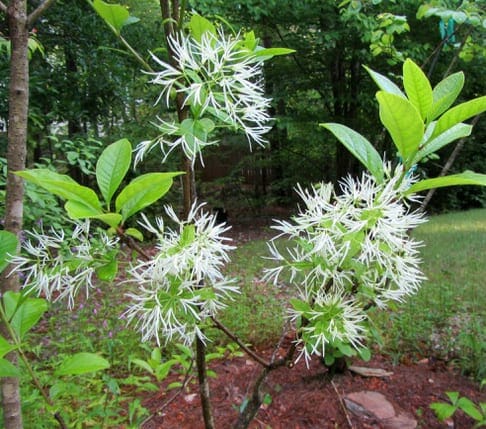
Terminal panicles on spring branches of Chionanthus virginicus.
Native Plants Need Native Flora: Habropoda laboriosa (Southeastern blueberry bee)
Deborah Ashley
One of the fun things about writing these articles for the newsletter is that I am learning about species that I never knew about. I just learned of a very interesting pollinator that we have in the US called the Southeastern blueberry bee. Ellen Honeycutt told me about this bee and offered her pictures of this “specialist” who focuses on pollinating blueberry flowers.
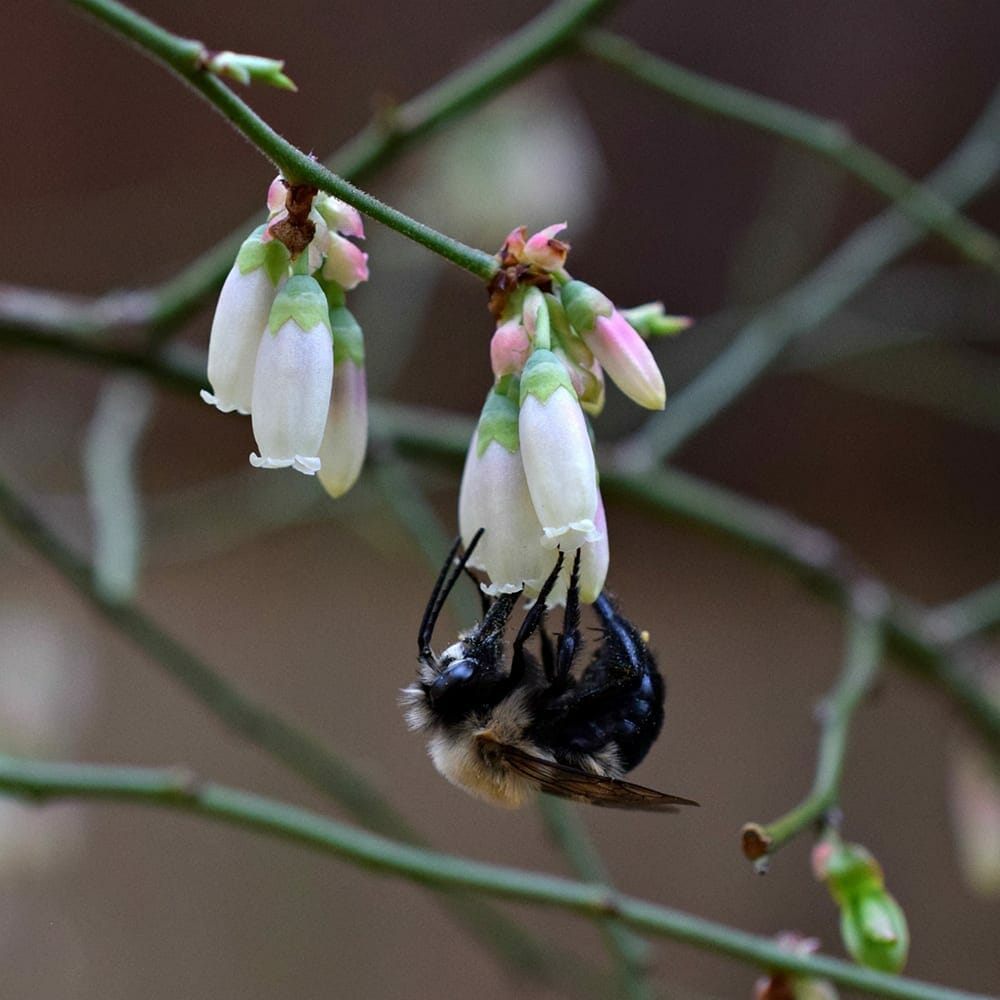
Bee harvesting pollen from blueberry flower. Photo by Ellen Honeycutt.
The Southeastern blueberry bee looks like a small bumble bee, with males having a yellow face, and females having a black face. They use a technique called sonification to loosen the heavy, sticky pollen found tucked away inside the long tubular flowers of the blueberry plant. During sonification they attach themselves to the flower and use their wing muscles to vibrate and shake the pollen loose. Then it’s on to the next flower bud to transfer the pollen sticking to their hairy bodies. They deposit it on the stigma of other flowers so that it can reach the ovule. Pollination needs are extensive in blueberries. Each bud can produce up to 16 individual flowers, with each flower being a potential blueberry.
These bees do use other native plants for nectar, such as the Eastern redbud (Cercis canadensis),Viburnum spp., Rhododendron spp., the clover family (Fabaceae), and trumpetflower (Gelsemium spp.). But their primary forage is blueberries (Vaccinium spp.). As a matter of fact, they emerge from their nests in the ground at about the same time most blueberries flower. They are most active from February through April.
Blueberry bees prefer sandy, soft soils or leaf litter to build their nest. The females make a tunnel and then make individual cells for each egg. The tunnel and cells are waterproof. To feed her larvae, she fills each cell with a mixture of nectar and pollen and lays only one egg on top of this. Then the next spring, the adult males emerge first. They then patrol the nest aggregation areas waiting for the females to emerge! Below is a picture of the black face of the female and another of the handsome male of this species. So the next time you’re watching blueberry flowers being pollinated, you’ll recognize the Southeastern blueberry bee!
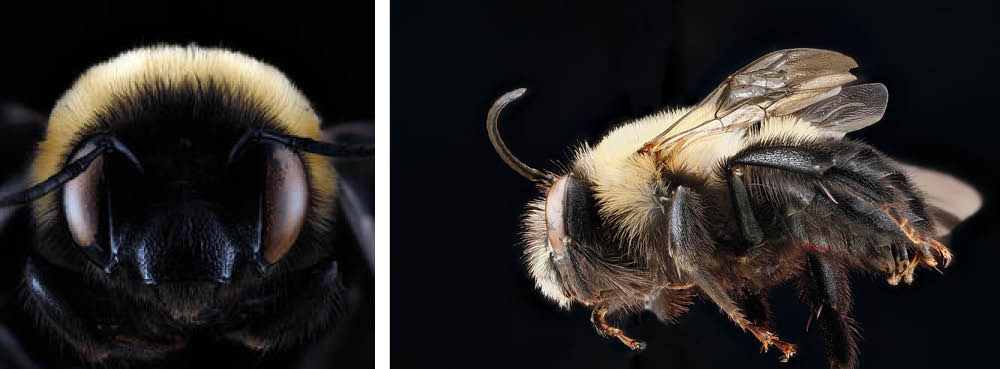
Left: Female Southeastern blueberry bee. Right: Male Southeastern blueberry bee. Both photos by USGSBIML Team. Public domain.
|